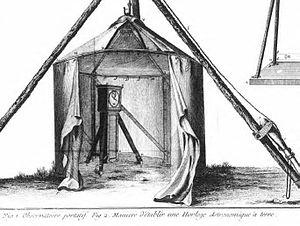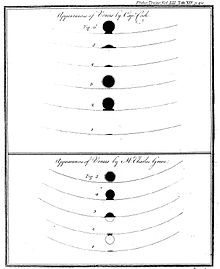
The astronomical unit is a unit of length, roughly the distance from Earth to the Sun and approximately equal to 150 million kilometres or 8.3 light-minutes. The actual distance from Earth to the Sun varies by about 3% as Earth orbits the Sun, from a maximum (aphelion) to a minimum (perihelion) and back again once each year. The astronomical unit was originally conceived as the average of Earth's aphelion and perihelion; however, since 2012 it has been defined as exactly 149597870700 m.
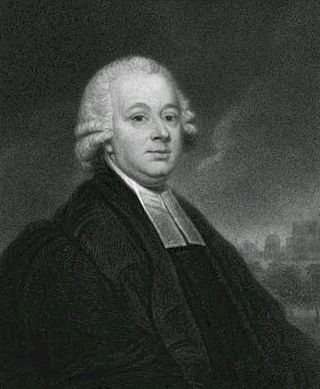
Nevil Maskelyne was the fifth British Astronomer Royal. He held the office from 1765 to 1811. He was the first person to scientifically measure the mass of the planet Earth. He created the British Nautical Almanac and Astronomical Ephemeris for the Meridian of the Royal Observatory at Greenwich using Johann Tobias Mayer's corrections for Euler's Lunar Theory tables.

Charles Mason was an English astronomer who made significant contributions to 18th-century science and American history, particularly through his survey with Jeremiah Dixon of the Mason–Dixon line, which came to mark the border between Maryland and Pennsylvania (1764–1768). The border between Delaware and Maryland is also defined by a part of the Mason–Dixon line.

Jeremiah Dixon FRS was an English surveyor and astronomer who is best known for his work with Charles Mason, from 1763 to 1767, in determining what was later called the Mason–Dixon line.

A transit of Venus across the Sun takes place when the planet Venus passes directly between the Sun and a superior planet, becoming visible against the solar disk. During a transit, Venus can be seen from Earth as a small black dot moving across the face of the Sun. The duration of such transits is usually several hours. A transit is similar to a solar eclipse by the Moon. While the diameter of Venus is more than three times that of the Moon, Venus appears smaller, and travels more slowly across the face of the Sun, because it is much farther away from Earth.
Charles Green was a British astronomer, noted for his assignment by the Royal Society in 1768 to the expedition sent to the Pacific Ocean in order to observe the transit of Venus aboard James Cook's Endeavour.

Neith is a hypothetical natural satellite of Venus reportedly sighted by Giovanni Cassini in 1672 and by several other astronomers in following years. It was 'observed' up to 30 times by astronomers until 1770, when there were no new sightings and it was not found during the transit of Venus in 1761 and 1769.
Thomas Hornsby was a British astronomer and mathematician.
Zachary Hicks was a Royal Navy officer, second-in-command on Lieutenant James Cook's first voyage to the Pacific and the first among Cook's crew to sight mainland Australia. A dependable officer who had risen swiftly through the ranks, Hicks conducted liaison and military duties for Cook, including command of shore parties in Rio de Janeiro and the kidnapping of a Tahitian chieftain in order to force indigenous assistance in the recovery of deserters. Hicks' quick thinking while in temporary command of HMS Endeavour also saved the lives of Cook, Joseph Banks and Daniel Solander when they were attacked by Māori in New Zealand in November 1769.
Herman Diedrich Spöring Jr. (1733–1771) was a Finnish explorer, draughtsman, botanist and a naturalist.
Benjamin West was an American astronomer, mathematician, professor, and author of almanacs.

The first voyage of James Cook was a combined Royal Navy and Royal Society expedition to the south Pacific Ocean aboard HMS Endeavour, from 1768 to 1771. It was the first of three Pacific voyages of which James Cook was the commander. The aims of this first expedition were to observe the 1769 transit of Venus across the Sun, and to seek evidence of the postulated Terra Australis Incognita or "undiscovered southern land".
William Wales was a British mathematician and astronomer who sailed on Captain Cook's second voyage of discovery, then became Master of the Royal Mathematical School at Christ's Hospital and a Fellow of the Royal Society.
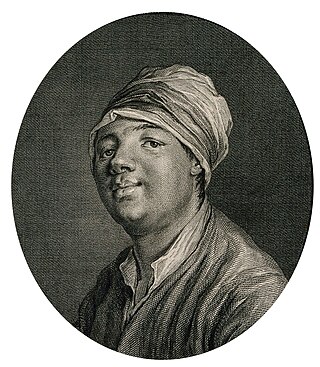
Jean-Baptiste Chappe d'Auteroche was a French astronomer, best known for his observations of the transits of Venus in 1761 and 1769.
William Bayly (1737–1810) was an English astronomer.

The 1874 transit of Venus, which took place on 9 December 1874, was the first of the pair of transits of Venus that took place in the 19th century, with the second transit occurring eight years later in 1882. The previous pair of transits had taken place in 1761 and 1769, and the next pair would not take place until 2004 and 2012. As with previous transits, the 1874 transit would provide an opportunity for improved measurements and observations. Numerous expeditions were planned and sent out to observe the transit from locations around the globe, with several countries setting up official committees to organise the planning.
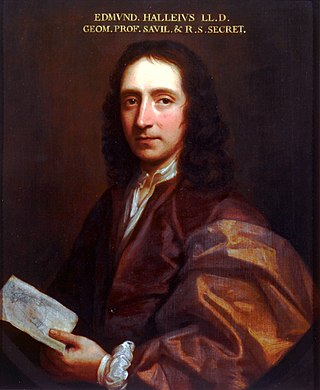
EdmondHalley was an English astronomer, mathematician and physicist. He was the second Astronomer Royal in Britain, succeeding John Flamsteed in 1720.
Matavai Bay is a bay on the north coast of Tahiti, the largest island in the Windward group of French Polynesia. It is in the commune of Mahina, approximately 8 km east of the capital Pape'ete.

The Kirkhill Astronomical Pillar was constructed in 1776 by David Stewart Erskine, 11th Earl of Buchan and erected in the grounds of his estate at Kirkhill House, near Broxburn, Scotland. The pillar fell into disrepair and eventually collapsed in the 1970's but fortunately the stones were preserved and the pillar was reconstructed (1988) in Almondell Country Park on land once owned by the Erskine family. The pillar records the details of an adjacent scale model of the Solar System constructed by Erskine following the measurements of the size of the Solar System deduced from the observations of the Transits of Venus in 1761 and 1769. The model, centred on a Sun of stone six feet in diameter with planets at distances and sizes to scale, has long since disappeared, only the pillar remains.

An Account of the Voyages Undertaken by the Order of his Present Majesty for Making Discoveries in the Southern Hemispheres, and successively performed by Commodore Byron, Captain Wallis, Captain Carteret, and Captain Cook, in the Dolphin, the Swallow, and the Endeavour: drawn up from the journals which were kept by the several commanders, and from the papers of Joseph Banks, Esq. is a 1773 book by John Hawkesworth about several Royal Navy voyages to the Pacific: the 1764–1766 and 1766–1768 voyages of HMS Dolphin under John Byron and Samuel Wallis, the voyage of HMS Swallow under Philip Carteret (1766–1769), as well as the 1768–1771 first voyage of James Cook on HMS Endeavour. Hawkesworth received an advance of £6,000 for editing the three volumes.


